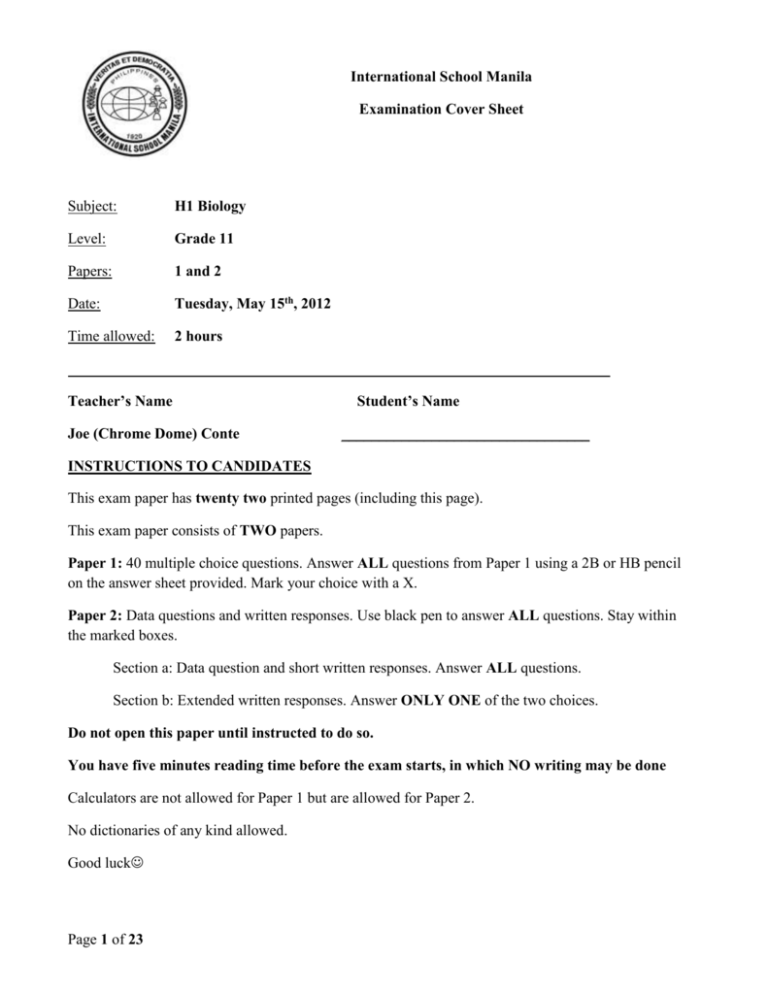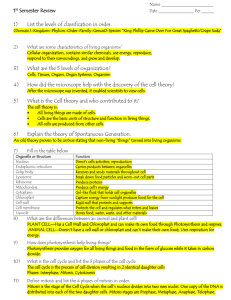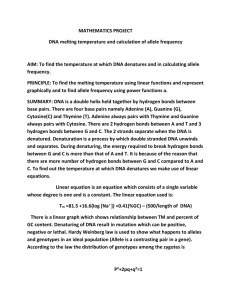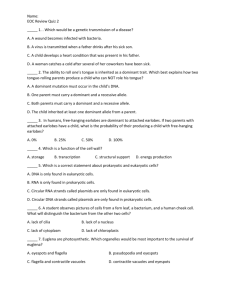Grade 11 Biology Exam Paper - International School Manila
advertisement

International School Manila Examination Cover Sheet Subject: H1 Biology Level: Grade 11 Papers: 1 and 2 Date: Tuesday, May 15th, 2012 Time allowed: 2 hours Teacher’s Name Joe (Chrome Dome) Conte Student’s Name _________________________________ INSTRUCTIONS TO CANDIDATES This exam paper has twenty two printed pages (including this page). This exam paper consists of TWO papers. Paper 1: 40 multiple choice questions. Answer ALL questions from Paper 1 using a 2B or HB pencil on the answer sheet provided. Mark your choice with a X. Paper 2: Data questions and written responses. Use black pen to answer ALL questions. Stay within the marked boxes. Section a: Data question and short written responses. Answer ALL questions. Section b: Extended written responses. Answer ONLY ONE of the two choices. Do not open this paper until instructed to do so. You have five minutes reading time before the exam starts, in which NO writing may be done Calculators are not allowed for Paper 1 but are allowed for Paper 2. No dictionaries of any kind allowed. Good luck Page 1 of 23 Paper 1 1. What does the size of the standard deviation indicate about data? A. How accurately the data were measured B. How widely the data are spread above and below the mean C. Whether the mean is larger or smaller than it should be D. Whether the reliability of the data is greater or less than 68 % 2. 10 000 melons were collected from plants in the same area. Assuming their sizes are normally distributed, how many melons would you expect to be within two standard deviations from the mean? A. 3 400 B. 5 000 C. 6 800 D. 9 500 3. Which hypothesis can be tested using the t-test? A. The difference in variation between two samples is not significant. B. The difference between observed values and expected values is not significant. C. The change in one variable is not correlated with a change in another variable. D. The difference between the means in two samples is not significant. 4. The diagram below shows a cell during mitosis. What is the stage of mitosis and what are the structures? A B C D Page 2 of 23 Stage of mitosis Structure I metaphase anaphase anaphase metaphase chromatid centromere chromatid centromere Structure II nuclear membrane plasma membrane nuclear membrane plasma membrane 5. If a mitochondrion has a length of 5 μm and a student’s drawing of the mitochondrion is 10 mm, what is the magnification of the drawing? A. ×0.0005 B. ×0.5 C. ×200 D. ×2000 6. Which of the following are features of prokaryotes and eukaryotes? 70S ribosomes 80S ribosomes Naked DNA DNA associated with proteins A prokaryote eukaryote prokaryote eukaryote B eukaryote prokaryote eukaryote prokaryote C eukaryote prokaryote prokaryote eukaryote D prokaryote eukaryote eukaryote prokaryote 7. Which of the following will contribute to the cell theory? I. Living organisms are composed of cells. II. All cells come from pre-existing cells by mitosis. III. Cells are the smallest units of life. A. I only B. II only C. I and III only D. I, II and III 8. Which of the following does not occur during interphase? A. Replication B. Translation C. Cytokinesis D. An increase in the number of mitochondria Page 3 of 23 9. How does the surface area to volume ratio change with an increase in cell size? C. 10. What principle is necessary to preserve the sequence of DNA during replication? A. Base pairing is complementary. B. One gene codes for one polypeptide. C. Substrates are specific to enzymes. D. The genetic code is universal. 11. What property of water makes it a good evaporative coolant? A. High latent heat of evaporation B. Relatively low boiling point C. Volatility D. Transparency Page 4 of 23 12. Which type of molecule is shown in the diagram below? A. Peptide B. Carbohydrate C. Lipid D. Nucleic acid 13. The percentage of thymine in the DNA of an organism is approximately 30 %. What is the percentage of guanine? A. 20 % B. 30 % C. 40 % D. 70 % 14. Oxygen is produced during photosynthesis. What is the source of this oxygen inside the plant? A. Air spaces in the leaf B. Carbon dioxide C. Glucose D. Water 15. The graph below shows the effect of substrate concentration on enzyme activity. What conclusion can be drawn about section X of the graph? A. The enzyme has started to denature and the reaction slows down. B. The reaction has finished and the substrate has been used up. C. The enzyme is saturated and is working at its maximum reaction rate. D. Some of the enzyme has been consumed and the reaction has reached a plateau. Page 5 of 23 16. Which of the following types of information are needed to construct a karyotype? I. Size of the chromosomes II. Gene mutations of the chromosomes III. Age of the individual A. I only B. II only C. I and II only D. I, II and III 17. During reproduction in flowering plants an embryo sac is produced, containing one haploid nucleus. This haploid nucleus divides by mitosis three times. What is produced? A. One diploid nucleus B. Four diploid nuclei C. Four haploid nuclei D. Eight haploid nuclei 18. A parent organism of unknown genotype is mated in a test cross. Half of the offspring have the same phenotype as the parent. What can be concluded from this result? A. The parent is heterozygous for the trait. B. The trait being inherited is polygenic. C. The parent is homozygous dominant for the trait. D. The parent is homozygous recessive for the trait. 19. The pedigree chart below shows the blood types of three members of a family. Which could be the blood types of individuals 1 and 2? A B C D Page 6 of 23 Individual 1 A A O B Individual 2 AB B B A 20. In the following diagram, which pair represents homologous chromosomes? A. 1 and 2 B. 3 and 4 C. 2 and 5 D. 4 and 6 21. Which of the following is the best definition of a community? A. A group of individuals that can interbreed and produce fertile offspring B. The number of individuals of the same species in a given area C. A group of populations living and interacting with each other in a given area D. The total number of individuals in a given area 22. Pseudolarix amabilis produces seeds but not flowers. Physcomitrella patens has leaves but not roots. To which groups do they belong? A B C D Pseudolarix amabilis coniferophyta filicinophyta coniferophyta angiospermophyta Physcomitrella patens filicinophyta angiospermophyta bryophyta coniferophyta 23. Population size is influenced by certain factors. If I = immigration, E = emigration, N = natality, M = mortality and (N + M) = (I + E) = 0, which phase is this population in? A. Exponential phase B. Transitional phase C. Plateau phase D. Growth phase Page 7 of 23 24. Which of the following are used as evidence for evolution? I. Homologous structures II. Selective breeding of domesticated animals III. Overproduction of offspring A. I and II only B. I and III only C. II and III only D. I, II and III 25. Which human activities may increase or decrease the greenhouse effect? Increases greenhouse effect Decreases greenhouse effect A Deforestation More use of fossil fuels B Reforestation More use of solar power C Less use of air conditioning Less use of public transport D More cattle farming Reforestation 26. The diagram below shows part of a DNA molecule that is being replicated. Template strand Where would DNA polymerase link the next nucleotide during replication? A. I B. II C. III D. IV Page 8 of 23 27. Where does the RNA polymerase bind during the process of transcription? A. The polysome B. The operator C. The promoter D. The initiator 28. During the process of translation which of the following statements describes the relationship between nucleic acids? A. Anticodons on mRNA bind to complementary codons on DNA. B. Anticodons on tRNA bind to complementary codons on mRNA. C. Bases on DNA bind to complementary bases on mRNA. D. A single strand of mRNA is produced from the DNA in the nucleus. 29. Consider the metabolic pathway shown below. If there is end-product inhibition, which product (B to E) would inhibit which enzyme (1 to 4)? Product A B C D Enzyme C B B E 4 3 4 1 30. What is the reason for Okazaki fragments being formed during DNA replication? A. To enable replication of the 3′ → 5′ (lagging) strand B. To form the template for the RNA primers C. To initiate replication on the 5′ → 3′ (leading) strand D. To help the DNA helicase unwinding the DNA helix 31. Which cellular component includes nucleic acid with structural protein? A. tRNA B. DNA polymerase C. Ribosome D. mRNA 32. What is the role of NADH + H + in aerobic cell respiration? A. To transfer hydrogen to the electron transport chain B. To reduce intermediates in the Krebs cycle C. To accept electrons from the electron transport chain D. To combine with oxygen to produce water Page 9 of 23 33. Which of the following is true of the link reaction of aerobic respiration? A. The reduction of FAD+ occurs. B. The decarboxylation of pyruvate occurs. C. It occurs in the cytoplasm. D. The regeneration of NAD+ occurs. 34. What reaction, involving glycerate 3-phosphate, is part of the light-independent reactions of photosynthesis? A. Glycerate 3-phosphate is carboxylated using carbon dioxide. B. Two glycerate 3-phosphates are linked together to form one hexose phosphate. C. Glycerate 3-phosphate is reduced to triose phosphate. D. Glycerate 3-phosphate is oxidized to three ribulose biphophosphate carboxylase (RuBP) 35. What is the advantage of having a small volume inside the thylakoids of the chloroplast? A. High proton concentrations are rapidly developed. B. High electron concentrations are rapidly developed. C. Photosynthetic pigments are highly concentrated. D. Enzymes of the Calvin cycle are highly concentrated. 36. How are photosynthesis and aerobic respiration similar? ATP synthetase enzyme Electron transport chain A B C D Yes No Yes Yes No No Yes Yes NADH + H+ No Yes Yes No 37. What are the main structures in a bulb and their function? A. Flowers for sexual reproduction B. Enlarged roots for nutrient absorption from the soil C. Swollen leaf bases for food storage D. Thickened stems for water storage 38. The photosynthetic activity of desert plants is often reduced in the middle of the day. What is the most reasonable explanation for this fact? A. Enzymes are denatured by the high temperatures. B. There is not sufficient water for photosystem I. C. Most of the light is reflected by the thick cuticle. D. The stomata close to preserve water and gas exchange decreases. Page 10 of 23 39. What are differences between monocotyledonous and dicotyledonous plants? Monocotyledonous Dicotyledonous A B C D parallel venation; floral organs in multiples of 4 or 5 net-like venation; floral organs in multiples of 3 net-like venation; floral organs in multiples of 4 or 5 parallel venation; floral organs in multiples of 3 net-like venation; floral organs in multiples of 3 parallel venation; floral organs in multiples of 4 or 5 parallel venation; floral organs in multiples of 3 net-like venation; floral organs in multiples of 4 or 5 40. What controls the flowering process in long-day plants? A. Pfr is converted by red light to Pr which acts as a promoter of flowering. B. Pr is converted by red light to Pfr which acts as an inhibitor of flowering. C. Pr is converted by red light to Pfr which acts as a promoter of flowering. D. Pfr is converted by red light to Pr which acts as an inhibitor of flowering. Page 11 of 23 PAPER 2: Section a Answer all questions. Write your answers in the boxes provided. 1. PanI is a gene in cod fish that codes for an integral membrane protein called pantophysin. Two alleles of the gene, PanIA and PanIB, code for versions of pantophysin, that differ by four amino acids in one region of the protein. Samples of cod fish were collected from 23 locations in the north Atlantic and were tested to find the proportions of PanIA and PanIB alleles in each population. The results are shown in pie charts, numbered 1–23, on the map below.The proportions of alleles in a population are called the allele frequencies. The frequency of an allele can vary from 0.0 to 1.0. The light grey sectors of the pie charts show the allele frequency of PanIA and the black sectors show the allele frequency of PanIB. 21 3 4 (This question continues on the following page) Page 12 of 23 (Question 1 continued) (a) (i) State the two populations with the highest PanIB allele frequencies. [1] (a) (i) (population) 1 and (population) 2 (both needed) (ii) State the population in which the allele frequencies were closest to 0.5. [1] (ii) (population) 11/7/7 and 11 (b) Deduce the allele frequencies of a population in which half of the cod fish had the genotype PanIA PanIA, and half had the genotype PanIA PanIB. [1] (b) PanIA 0.75 and PanIB 0.25 / 3 PanIA to 1 PanIB [1] Both must be correct for the mark to be awarded, accept frequencies in form of ratio. (This question continues on the following page) Page 13 of 23 (Question 1 continued) The graphs below show the latitude and the mean surface sea temperature in June of the sampling locations and the frequency of the PanIA allele. (c) State the relationship between: latitude and the frequency of the PanIA allele. (i) [1] (c) (i) greatest/great frequencies of PanIA at lowest/low latitudes / a rapid drop in frequency at (60–65 degrees latitude) / lowest/low frequencies at highest/high latitudes [1] Answers which describe/imply the correct step-wise relationship should get credit. Answers stating or implying a negative correlation alone should not get credit. (ii) mean surface sea temperature in June and the frequency of the PanIA allele. (ii) lowest/low frequencies of PanIA at lowest/low temperatures / a rapid increase in frequency at (8–10 degrees Celsius) / highest/high frequencies at warmest/warm temperatures [1] Page 14 of 23 [1] Answers which describe/imply the correct step-wise relationship should get credit. Answers stating or implying a negative correlation alone should not get credit. (This question continues on the following page) (Question 1 continued) (d) Suggest how natural selection could have caused the relationships shown in the graphs. [2] (d) (cod with) PanIA allele selected/favoured/better adapted to warmer water; (cod with) PanIB allele selected/favoured/better adapted to colder water; cod that survive can reproduce and pass alleles on to offspring; [2 max] It takes a whole organism to reproduce in order to pass on the allele, hence we expect reference to the fish to gain this last marking point (e) The sites close to Iceland, at a latitude of 60–65o, had very varied allele frequencies, with both PanIA and PanIB occurring. The water at these sample sites was highly stratified, with much warmer water at the surface and much colder water below. Suggest reasons for both PanIA and PanIB alleles occurring at these sites. [2] (e) higher frequency of PanIA/PanIA PanIA (cod) in warm (surface) water; higher frequency of PanIB/PanIB PanIB (cod) in colder (deeper) water; interbreeding results in PanIA PanIB cod/heterozygous cod; (f) Using the data in this question, predict the effects of global warming on cod fish populations. PanIA PanIA (cod) may spread further north / PanIB PanIB (cod) may move/retreat further north; numbers of PanIA PanIA (cod) may increase / frequency of PanIA allele may increase; Page 15 of 23 [2] PanIB PanIB (cod) may become extinct / frequency of PanIB allele may decrease; End of data question 2. a. (i) In the space provided below, construct a Punnett grid showing a monohybrid cross between a colour blind man and a heterozygous woman. (ii) Based on your Punnett grid, predict the phenotypes of the offspring 25% chance colourblind son, 25% chance normal vision son 25% chance colourblind daughter, 25% chance carrier daughter Page 16 of 23 [1] b. The diagram below shows the pedigree of a family with red green colour-blindness, a sexlinked condition. Key 1st generation 1 normal male 2 normal female male with condition 2nd generation 1 2 1 2 3 4 5 3 4 female with condition 3rd generation (i) Define the term sex-linkage. [1] The condition in which a gene responsible for a specific trait is located on a sex chromosome, (Question 2 continued) (ii)Deduce, with a reason, whether the allele producing the condition is dominant or recessive. [2] Recessive, because individual 3rd generation number 2 has the condition and both of her parents do not have the condition. If the condition was dominant then one of her parents must have the condition and at least one would be shaded in, neither are shaded in therefore the condition cannot be dominant, it is recessive. (iii) Determine all the possible genotypes of the individual (2nd generation-1) using appropriate symbols. [1] XcY Page 17 of 23 (iv) Determine all the possible genotypes of the individual (3rd generation-4) using appropriate symbols. [1] XCXC or XCXc (c) Distinguish between unique or single-copy genes and highly repetitive sequences in nuclear DNA. 3. (a) Outline three adaptations of xerophytes that allow them to conserve water. [3] [3] Sunken stomates: creates a humid environment around the stomata which reduces lowers the water concentration gradient between inside and outside the leaf thereby reducing transpiration Extensive root system:………………….. Needle shape leaves…………………….: Page 18 of 23 (b) Draw and label a diagram showing the structure of a named dicotyledenous animalpollinated flower. [3] Philippine red sampaguita Page 19 of 23 PAPER 2 Section b Answer only one of the questions. 4. (a) State four functions of proteins, giving a named example of each. [4] (b) Outline the structure of ribosomes. [6] (c) Explain the process of transcription leading to the formation of mRNA. [8] 5. (a) Annotate a labeled diagram of the ultrastructure of Escherichia coli as an example of a prokaryote. [4] (b) Describe the events that occur in the four phases of mitosis in animals. [6] (c) Explain the process of aerobic cell respiration after glycolysis has occurred. [8] 4 a. transport of oxygen, haemoglobin structure, collagen enzymes, helicase movement, myosin b. ribosomes are the site of polypeptide synthesis two subunits, large and small subunits, 70S in prokaryotes / 80S in eukaryotes; each subunit is composed of rRNA and proteins subunits come together in translation to make a functional ribosome ribosomes have three binding sites for tRNA molecules ribosomes have one binding site for mRNA molecule can be free / bound to RER (in eukaryotes); Page 20 of 23 c. . RNA polymerase; (polymerase number is not required) binds to a promoter on the DNA; unwinding the DNA strands; binding nucleoside triphosphates; to the antisense strand of DNA; as it moves along in a 5'→3' direction; using complementary pairing/A-U and C-G; losing two phosphates to gain the required energy; until a terminator signal is reached (in prokaryotes); RNA detaches from the template and DNA rewinds; RNA polymerase detaches from the DNA; many RNA polymerases can follow each other; introns have to be removed in eukaryotes to form mature mRNA; Page 21 of 23 a. . b. Mitosis is a stage of the cell cycle. Mitosis is division of the nucleus in which one parent nucleus divides into two daughter nuclei each genetically identical to the parent nucleus. It produces nuclei for cells involved in growth, asexual reproduction (of eukaryotes), embryonic development and tissue repair. Before mitosis commences each chromosomes makes an identical copy of itself in the S – phase of interphase. After this the cell enters into mitosis. Mitosis has four stages; prophase, metaphase, anaphase and telophase. Stage 1: Prophase. During prophase……………. As seen in figure 1, the nuclear membrane is breaking down……… Stage 2: Metaphase Stage 3: Anaphase Stage 4: Telophase Page 22 of 23 c. Aerobic cell respiration is the breakdown of organic molecules namely glucose which requires the use of oxygen to release energy from the organic molecules. The processes occurring in aerobic cellular respiration after glycolysis are: the link reaction, the Krebs cycle and oxidative phosphorylation. These processes occur only when oxygen is available. Link reaction: Occurs in the matrix of the mitochondria. Pyruvate undergoes oxidative decarboxylation acetyl CoA Krebs Cycle: Occurs in the matrix of the mitochondria Acetly group enters the Krebs cycle and combines with a 4 carbon compound to make a 6 carbon compound. One turnoff the Kreb’s cycle generates 1 x FADH2, 1x ATP, 3 x (NADH + H+), 2 x CO2 Oxidative phosphorylation: Occurs on the inner membrane of the mitochondria. It has two parts. Chemiosmosis (ETC) Phosphorylation(ADP +Pi ATP) Page 23 of 23









